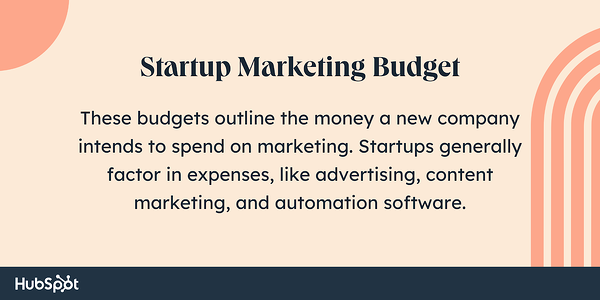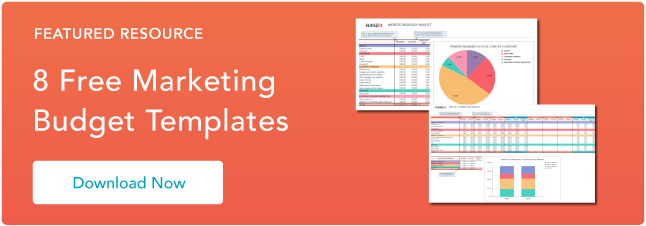When proposing potential ads at your startup, one of the first questions you’ll likely encounter is, “How much will this cost?” If you’ve prepared a killer startup marketing budget, you will be well-equipped to help executives understand and buy into your vision.
A marketing budget should detail how much you’ll spend on paid advertising, fit into your overall strategy, and prove a worthy expenditure based on revenue earned.
In a world where 82% of startups fail from cash flow problems, the stakes are higher for these new businesses. Startups often face limited resources and smaller budgets, making it difficult to stake claim to a marketing budget.
This post covers how to determine what your marketing budget should be and what it needs to include.
Table of Contents
- Marketing Costs for a Startup
- Startup Marketing Budget Considerations
- Tips for Writing a Startup Marketing Budget
- How to Write a Startup Marketing Budget
Marketing Costs for a Startup
When your company is new, determining an initial marketing budget can be confusing. In some cases, budget decisions are top-down, inspired by competitors, or made by setting a goal.
If this isn’t the case for your startup’s operations, focus first on what will bring in the most revenue. Revenue determines what your marketing budget should be and where funds should be allocated.
The money gained from your gross revenue should fund your marketing budget. So, how much of your gross revenue will you need? The average marketing budget for startups should be 11.2% of overall revenue. This percentage gives marketers enough resources to build brand awareness and start attracting leads.
If you’re starting your budget from scratch, consider using a marketing budget template to outline your phase one marketing activities and costs.

Download Free Marketing Budget Templates
To identify your gross revenue, calculate your total number of sales/increases.
If you don’t have a gross revenue estimate yet, determine how much you are projecting to make and use those numbers as benchmarks. Explore tools to help you estimate your gross revenue, like this online calculator from the Small Business Association.
Now that you understand the first step to making a budget, explore other potential needs you may have.

Startup Marketing Budget Considerations
So, what do you need to include in your budget?
Once you have money earmarked, you can begin breaking down the costs. Think of what costs naturally occur in your day-to-day and what resources you’ll need to make your marketing happen.
You can put this information in a spreadsheet or template, like these free marketing offerings from HubSpot.There are no real rules with budget design, as long as it’s comprehensible and detailed enough to be useful.
Remember to consider the following expenses, such as:
- Technology. When you are creating campaigns, factor in the technology you need to use, such as software to build a product page or manage a drip program. There are lots of marketing tools at different price points (and even free software), so be sure to write out what software you’ll need to buy. Check out this blog to determine which products fit your budget.
- Research. If you haven’t yet discovered your target audience, you may need to invest in market research. Read the section “How to Write a Startup Marketing Budget” below for more info on market research.
- Automation. Services that automate marketing processes can make your life much easier. They can also be advantageous to startups that don’t have the resources to spend money on extra hands to complete projects.
- Production. If you need content pieces, product or advertisement videos, or pictures, you will want to budget for these items as well. Instead of paying for multiple different services, you could hire freelancers to fill these roles.
- Paid advertising. Are you planning to run ads on TV, radio, or online? This is the category where you factor in those costs. It’s easy for paid advertising to add up, with some startups spending as much as 20% of their yearly budget on advertising alone. Remember, you can estimate the cost of paid ads. Take a look at our advertising guide to explore prices on anything from PPC ads to social media ads.
- Branding. Assets that build a first impression directly impact your branding. This might include business cards, billboards, swag, and signs.
- Content marketing. Decide how much you’re going to allocate to deliverable content. Consider automation services, likeHubSpotorSprout Social, and content ideas you can produce organically for free.
- Traditional advertising. If applicable to your business, make traditional advertising a line item. Paid advertising usually occurs online, but traditional advertising refers to advertisements such as print and billboards.
- New employees. If you plan on growing your team with full-time or part-time staff, you will likely need to include their costs in your marketing budget.
- Unexpected costs. Expect the unexpected when figuring out your budget. Plan for devices to break or campaigns to take longer than you think they will, generating higher costs.
Working from your business goals helps you make guided budgeting decisions. For example, if your company’s goal is to increase brand awareness, you’ll probably want to devote most of your budget to branding, content marketing, and paid advertising.
Remember that you can play around with free methods for most of these costs. For example, if you are certain that automated software will help your startup, explore free trials or free services that you can use to determine what’s worth the cost.
Tips for Writing a Startup Marketing Budget
Before writing your startup marketing budget, consider the following tips.
1. Check that investments are worthwhile.
Startups have limited resources and need quick wins. Your first goal should always be to get leads for sales. Before committing to an expenditure, ask yourself, “How does this empower sales?” If the answer isn’t obvious, it’s likely not worth the money.
2. Do competitor research.
Check out your main competitors’ websites and blogs. What articles are they writing about? What keywords are they targeting? And, ultimately, how can you improve upon their strategy?
Remember that SEO is a long game, and you likely won’t see immediate wins. However, you should optimize your articles from the beginning to create the right SEO foundation.
3. Understand your customer’s journey.
There’s a reason why your customers chose you. Understanding their buyers’ journeys is valuable information. This knowledge can help you determine which channels are effective and worth budgeting for.
4. Prepare to report on your ROI (return on investment).
You will be accountable for how your marketing budget is spent. Make sure you keep track of the leads you gather and the revenue that can be attributed to marketing.
When you need to report your ROI at the end of the year, you’ll already have data at your fingertips.
5. Review your marketing budget yearly.
Between inflation and economic changes, your budget will almost certainly need an annual review.
In fact, 48% of marketers predict their budget will increase in 2023, according to HubSpot Research. Whether your budget grows or shrinks, you should be ready to make adjustments.
How to Write a Startup Marketing Budget
As a marketing leader, you must set a budget and determine how the money will be spent. This step-by-step guide shares how you can write a clear, concise marketing budget for your startup.

1. Calculate your revenue, and determine your budget.
Remember, startups typically need to allocate 11% of their revenue(before taxes) to marketing in order to grow. So deciding your budget is as easy as determining 11 percent of your gross revenue, right?
Maybe, but your marketing budget likely needs executive approval. Plus, you’ll want to back up your budgetary decisions with statistics and a solid plan.
Once you’ve identified your overall plan, you can get a ballpark budget estimate. As a guide, think about your business and campaign goals. From those goals, choose the areas you want to invest the most in.
2. Conduct market research.
Thoughtful research can determine which of your products have the best potential for paid marketing campaigns. You’ll also find out which channels attract the most leads.
Remember: Conducting market research might cost you money and require a spot in your budget. This is especially true if you need to incentivize customers to participate with gift cards or promotions.
3. Work with product and sales to identify campaigns.
Your startup sales and product teams have valuable insight into which products need marketing’s special attention. Work closely with these teams to identify which campaigns you want to roll out during the year.
4. Create a marketing calendar.
Assign marketing campaigns potential dates and costs, spreading them out throughout the year, so you don’t use your budget all at once. Once you’ve created a potential calendar, it’s time to get your startup marketing budget approved.
5. Get executive buy-in.
By this point, you should have a solid marketing budget outline. Your marketing budget will likely need explaining and persuasive reasoning.
Make sure you communicate the strategy behind every cost. Finally, be sure to highlight exciting opportunities and how they play into your budget decisions.
Getting Started
A clear marketing budget can help you grow your startup business. By keeping track of expenses and allocating funds towards essential needs, you can reach your campaign goals.
Having a marketing budget can also ensure you have the freedom you need to make decisions without having to run every idea past executives.
Be sure to leverage the passion your startup company has for its product to make marketing a successful and exciting endeavor.
Editor’s Note: This post was originally published in March 2020 and has been updated for comprehensiveness.
![]()


